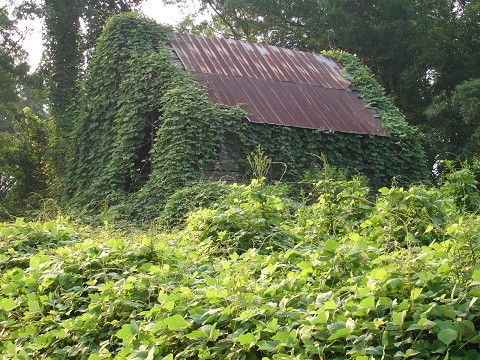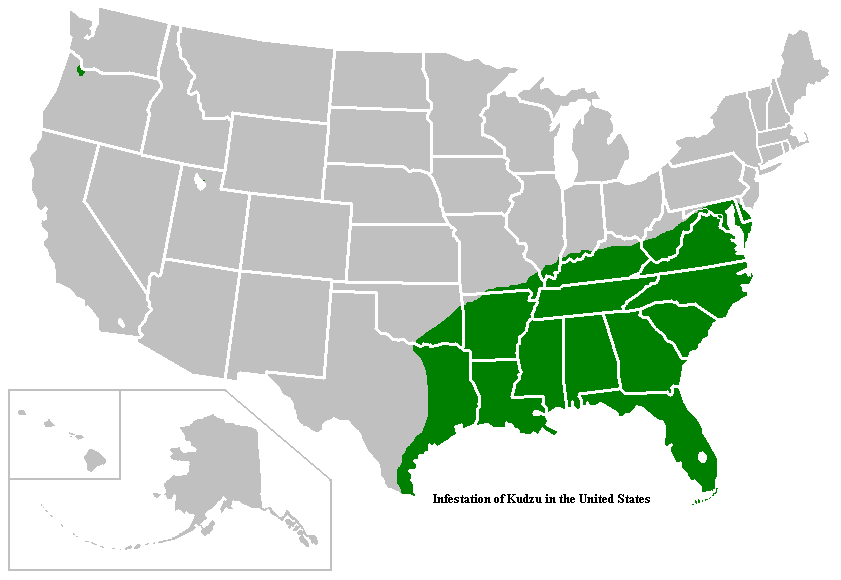Kudzu A.K.A. “the vine that ate the south” is a very hardy ornamental vine brought to the US in the late 1800s to help control soil erosion and to hopefully provide a food source for cattle and other livestock.
But the kudzu vine found a perfect home in the southeastern US. The rainfall and mild temperatures of this region provided excellent growing conditions. It’s rumored that the kudzu vine can grow up to one foot per day. Stories also abound of people returning from vacation to find their vehicles and homes engulfed in this invasive vine.

Barn covered with Kudzu vine.
While the spread of kudzu across the south is a huge environmental disaster the U.S. Forestry Service believes the spread of the vine to be only 2,500 acres per year instead of the previously estimated 150,000 acres consumed by kudzu annually. If you’ve ever driven interstates through the South you’ve seen the kudzu vine engulfing trees, entire sections of forest and everything else that gets in it’s way. To learn more about the kudzu vine invasion of the south checkout this Wikipedia article : Kudzu in the United States
But all is not lost. The kudzu plant is edible for us humans.
Preparing and Eating Kudzu
Most of the kudzu plant is edible except for the actual vine itself. The leaves, vine tips and shoots, flowers and roots can be safely consumed by humans. Also do not eat the pods or seeds. They are not edible.
The leaves of the kudzu plant can be prepared and eaten just as you would with spinach. Fresh or cooked. The tender young leaves are the leaves you want to eat. As the leaves mature they’ll get really tough and could be too much for your digestive system to handle. The leaves also have a fuzzy texture to them which many people won’t like. Flash boiling or cooking will wilt the fuzzy coating so it’s not a bother. I bet they’d make good southern style greens!
The shoots and young vine tips are reportedly similar to the taste of snow peas and the flowers are used to make jellies, jams, and even wine. Stir fried or steaming is a common cooking technique for the tips and shoots.
The roots of the kudzu plant are also technically edible. The best roots aren’t the ones that grow close to the surface but you have to dig down for. In a survival situation you can harvest young slender roots, remove all the bark and then suck out the nutrients. It’s not recommended to eat the whole root as it’s more wood than just starch like a potato.
The roots are also dried and then pulverized into powder and subjected to a series of rinses to remove the starch. The starch is then used for thickening soups and breading foods to be deep fried. The starch is prized for soups because it dissolves better than other thickening agents and enhances the taste of sweeter soups.
Here are some resources for kudzu recipes and techniques:
http://echorailton.com/kudzu-cookbook/
http://www.southernangel.com/food/kudzurcp.html
You may need to get creative with recipes and preparing the kudzu plant as it’s not a common practice here in the US.
Kudzu as medicine
The kudzu vine has been used in China for it’s medicinal properties with records of such use dating back to 200 BC. Kudzu is commonly used to treat alcoholism and reduce the effects of an alcohol hangover.
You can order some kudzu tea before your next bender here: http://www.kudzutea.net/
The use of kudzu for medicinal reasons while recognized isn’t backed up by tons of science. Here’s some more info on kudzu as a medicine from webmd: http://www.webmd.com/vitamins-supplements/ingredientmono-750-kudzu.aspx?activeingredientid=750&activeingredientname=kudzu
Harvesting Kudzu
Kudzu grows throughout the Southeast and reportedly as far north as Canada on the Eastern coast. It’s spread has slowed some but due to its hardiness will likely continue spreading unless severe action is taken. It is cold hardy but the cold seems to keep it from spreading like wildfire.
Here is a handy guide on identifying kudzu: http://www.wikihow.com/Identify-Kudzu
The shape of kudzu leaves can mimic the shape of poison ivy since they both have three leaves that are lobed. But with just a little practice it’s easy to tell. If you aren’t confident in identifying poison ivy vs. kudzu do your research first.
Here is a map of where the infestation is concentrated:

Kudzu vines aren’t poisonous but they do grow very dense so protective clothing is recommended when harvesting. Jeans and a long sleeve shirt with thin work gloves should suffice. Critters can hide in the leaves so sort through your harvest before you take it inside.
Remember you want to harvest the young tender leaves and shoots. If you try cooking any mature parts of the plant you’ll be sorely disappointed in the outcome.
Roots are even harder to harvest. Harvesting the roots can be very labor intensive as the tap roots for one plant can grow as large as 400 pounds. You won’t be going after those but looking for the young roots more easily dug up but not by the surface. Processing the roots into a food source is very labor intensive. But can be handy in a pinch for survival nutrients.
Even though importing and spreading kudzu in the United States turned out to be ecologically disastrous … at least there’s a leafy green bright side. The knowledge of how to eat and prepare kudzu could come handy in the case of food shortages.
Are you interested in trying out a kudzu recipe. If you do please share your results!
